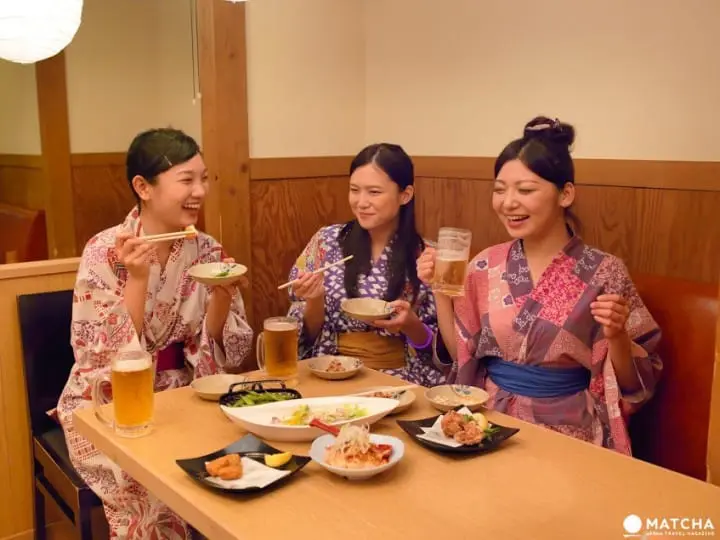7 Table Manners in Japan You Should Know Before Visiting

Japan has certain etiquette for eating, which reflect the overall cultures and values of the country. Here is a guide to basic manners you should pay attention to when dining out in Japan.
The Secret to Enjoying Delicious Japanese Food

We hope you enjoy the amazing Japanese food when you come to Japan. Whether it be sushi, yakiniku (Japanese barbecue), ramen, or meal sets that recreate home cooking, it’s because you’re in Japan that it’s possible to eat such a variety in flavors.
Table manners should also be taken into consideration to have a pleasant meal. Some mannerisms that are considered taboo in Japan not found in other countries.
We introduce basic table manners you should pay attention to when eating at a Japanese restaurant. Check this list beforehand so you won’t be confused when at a restaurant or at someone's house.
-
Table of Contents
- 1. Only Use Wet Towels to Wipe Your Hands
- 2. Say Thanks Before and After Your Meal
- 3. Use Chopsticks the Right Way
- 4. Hold Your Rice Bowl While Eating
- 5. Don’t Eat with Elbows on the Table
- 6. Slurp While Eating Noodles and Drinking Tea
- 7. No Leftovers is Basic Etiquette
1. Only Use Wet Towels to Wipe Your Hands

Most Japanese restaurants will bring you a wet hand towel upon entering the restaurant.
Different variations are given depending on the restaurant, such as wet disposable paper tissues or re-useable cloth towels, but these towels are specifically for wiping your hands.
For cloth towels, especially, avoid using them for other purposes besides wiping your hands. Do not use it to wipe your face, mouth, or the table.
2. Say Thanks Before and After Your Meal

In Japan, we place our hands together to pay our respects to the food before and after our meal. “Itadakimasu” is said before a meal and “Gochiso-sama” is said after a meal. Both phrases are said with two different forms of gratitude.
Its first meaning is to give gratitude to all the people that participated in the meal. This gratitude goes towards everyone who took part in growing the ingredients and cooking the meal so that we, the consumers, can eat this dish.
The second meaning is gratitude towards the ingredients. The consumption of meat and fish is equivalent to receiving the lives of once living animals.
Vegetables are also considered to have life. Thus, we give our gratitude to other lifeforms that convert into energy to keep us alive.
3. Use Chopsticks the Right Way

Chopsticks are the main utensil used in Japan when eating.
There are several set rules when it comes to how to use chopsticks while eating, starting from the way you hold your chopsticks. These rules take into consideration the person you are eating with to avoid making them uncomfortable.
Can You Request a Fork?
If you have trouble eating with chopsticks, please ask an employee if forks are available. It will depend on the restaurant, but some places will bring you a fork upon request.
4. Hold Your Rice Bowl While Eating

Most restaurants will serve you a bowl of rice and miso soup when ordering Japanese dishes or a meal set. When eating these dishes, it is considered proper manners to eat while holding a bowl in your hand.
Bowls with a weight holdable in one hand are great for this. Examples include rectangular lacquered boxes, small rice bowls, dishes, and side dishes.
Eat while holding your bowl in one hand and your chopsticks in the other to create a beautiful posture. However, don’t force yourself to hold flat dishes and large bowls of ramen or udon.
5. Don’t Eat with Elbows on the Table

Eating with your elbows on the table makes you appear worse with bad posture and will make the experience unpleasant for those eating around you.
Instead, eat with your elbows raised or place the hand without chopsticks on the table with the tableware.
6. Slurp While Eating Noodles and Drinking Tea

This is not mandatory, but it is good practice to eat Japanese dishes such as miso soup, ramen, udon, or tea with slurping sounds. It is common to use your chopsticks when eating noodles or solid ingredients. Drinking soups while holding the bowl in both hands.
However, not all sounds are good sounds. The noise made when setting down tableware or eating while making chewing noises is a manner violation. Blowing your nose during a meal is also something you should do far from the table.
If you are confused about what sounds are acceptable, then it is safer to eat quietly.
7. No Leftovers is Basic Etiquette
For your food, only order the amount that you’re able to finish. Finishing your plate is considered an act of gratitude towards the ingredients and the people who made your meal.
If you have allergies or things you cannot eat, let the staff know what they are when ordering. Some restaurants will remove those ingredients before serving it to you.
If you’re so full that it’s impossible to finish your food, then please don’t force yourself. Instead, it is best to express your gratitude to the staff by saying, “It was delicious (Oishikatta desu).”
Enjoy Eating in Japan like a Local!
During your long-awaited meal, it would be a waste to make others uncomfortable by having poor manners. Practice proper etiquette, and your food experience in Japan will be all the more memorable!
Read also
Main image courtesy of Pixta
This is the official account of MATCHA's editorial department. Our articles feature useful travel information for visitors to Japan, from how-to guides to recommended places to visit.








































![[Corporate Visit List] Near Kansai Airport! Discover Japan’s Technology and Business Philosophy through Industrial Tourism](https://resources.matcha-jp.com/resize/720x2000/2024/12/13-215168.webp)
![["Secret Beauty: The Complete Works of Komura Setsutei" ~ March 1, 2026] "Abeno Harukas Art Museum"](https://resources.matcha-jp.com/resize/720x2000/2026/01/09-255274.webp)